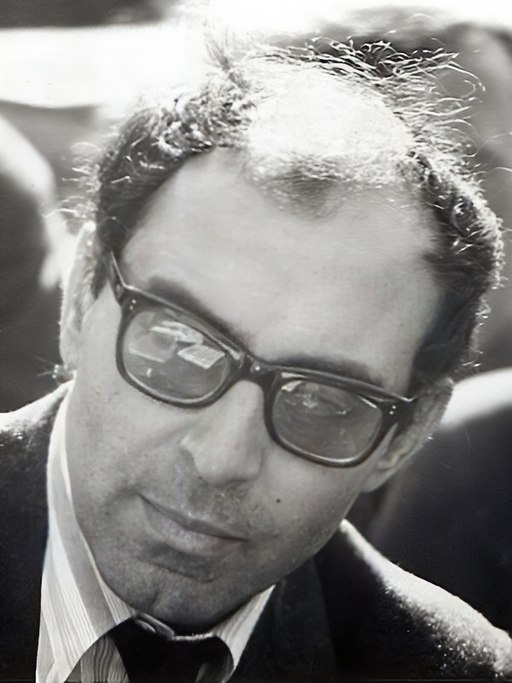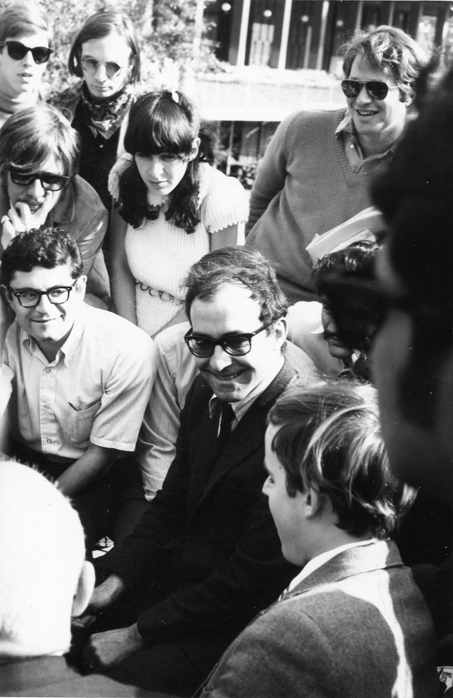Jean-Luc Godard
back| Full Name | Jean-Luc Godard |
| Born | December 3, 1930 |
| Birthplace | Paris, France |
| Died | December 13, 2022 |
| Buried | Cremated in private surroundings |
| Married to | • Anna Karina (1961–1967) • Anne Wiazemsky (1967–1979) |
| Children | None |
| Notable films | A Bout de Souffle - Le Mépris - Weekend - Passion - Film Socialisme |
Jean-Luc Godard – The “Master of Jump Cuts” and Avant-garde filmmaker
Jean-Luc Godard (1930 – 2022) is an avant-garde French-Swiss filmmaker and a pioneering figure of the French New Wave cinema of the 1960s. Born on December 3, 1930, in Paris, he initially delved into film criticism before transitioning into filmmaking. His debut, "Breathless" (1960), is often cited as a groundbreaking work, introducing innovative editing techniques and a non-linear narrative style. Godard's films are known for their political and philosophical underpinnings, breaking conventional cinematic norms.
Throughout the 1960s, Godard produced a series of influential films, including "Vivre sa vie" (1962), "Contempt" (1963), and "Pierrot le Fou" (1965), blending narrative with documentary, fiction with reality. His later works became more experimental and political, reflecting his Marxist leanings.
Godard's style is characterized by jump cuts, fragmented narratives, direct addresses to the audience, and an often playful approach to the medium. His work has been both celebrated for its innovation and critiqued for its challenging nature. Regardless, his influence on modern cinema is undeniable, with directors like Quentin Tarantino and Martin Scorsese citing him as a major influence. Today, Godard remains an enigmatic and vital presence in world cinema.
One of the signature techniques Godard introduced in his early films was the jump cut, which became a stylistic hallmark of the French New Wave.
Related
Jean-Luc Godard - Biography and movies
Early Life
Jean-Luc Godard was born on December 3, 1930, in Paris, France. He grew up in a bourgeois Protestant family. His family moved to Switzerland during World War II. Godard later returned to Paris to study ethnology at the Sorbonne, but his real passion was cinema.
Entering the Film World
During the 1950s, he began engaging with the vibrant Parisian film culture, frequenting the Cinémathèque Française, where he, along with future directors and critics like François Truffaut, Jacques Rivette, and Claude Chabrol, absorbed the vast history of film.
Godard initially made a name for himself as a critic for the influential film magazine "Cahiers du Cinéma." Along with his contemporaries, he laid the groundwork for what would later be known as the auteur theory, which posited the director as the primary creative force behind a film.
The French New Wave
In 1959, he made his directorial debut with "Breathless" (À Bout de Souffle), starring Jean-Paul Belmondo and Jean Seberg. It was a groundbreaking film that ushered in the French New Wave (La Nouvelle Vague). The film was marked by its jump cuts, on-location shooting, and its breezy, yet poignant narrative. It was revolutionary for its time and announced Godard as a major new voice in cinema.
Throughout the 1960s, Godard produced a barrage of films, further establishing himself as a force to be reckoned with in the world of cinema. Films like "Vivre sa Vie," "Contempt," and "Pierrot le Fou" became classics, known for their innovative storytelling, political undertones, and the often improvised nature of their production.
His iconic movie “Breathless” (A Bout de Souffle)
"À Bout de Souffle" (often translated as "Breathless" in English) is not just one of Jean-Luc Godard's most famous films, but it's also among the most iconic and influential works in the history of cinema.
Plot and Style of A Bout de Souffle
The plot follows a young car thief named Michel (played by Jean-Paul Belmondo) who, after killing a police officer, is on the run. He hides in Paris and tries to convince a young American woman, Patricia (played by Jean Seberg), whom he's been involved with, to flee with him to Italy. The film's narrative is simple, but it's told in a revolutionary style.
Godard's filmmaking in "Breathless" broke away from many conventional techniques. Notably, he made extensive use of jump cuts — abrupt cuts from one scene to a slightly advanced continuation of the same scene — which gives the film a fragmented, disjointed rhythm. This was considered very unconventional at the time, challenging traditional notions of film editing.
Production
The film was shot on a minimal budget using handheld cameras, natural lighting, and on-location in the streets of Paris. This gave "Breathless" an immediate, documentary-like feel, a vast departure from the polished, studio-bound productions common in that era.
Furthermore, Godard often employed improvisation, not just in terms of dialogue but also in the way scenes were set up and shot. This added to the film's spontaneous, fresh energy.
Influence and Impact
"Breathless" is considered a seminal work of the French New Wave movement. The New Wave filmmakers were known for their rejection of traditional filmmaking conventions in favor of more experimental and personal approaches. Godard's film perfectly embodies this ethos.
The film was an unexpected commercial and critical success, especially considering its experimental nature. It appealed to the youth of the time and represented a seismic shift in how films could be made and perceived. The casual amorality of its lead character, combined with its innovative style, made it a touchstone for countercultural movements worldwide.
Legacy of Breathless
"Breathless" is more than just a film; it's a statement about cinema itself. It pushed boundaries, introduced new techniques, and offered a fresh narrative voice. Many modern directors, from Martin Scorsese to Quentin Tarantino, have cited the influence of "Breathless" on their work.
Godard's daring and willingness to disrupt the status quo paved the way for generations of filmmakers to think outside the box, challenge conventions, and tell stories in new and exciting ways.
In conclusion, "À Bout de Souffle" is not just Godard's most famous work but a foundational text in the lexicon of modern cinema. Its influence can still be felt today, more than six decades after its release.
Analysis of Jean-Luc Godard’s style of filming
Jean-Luc Godard is one of cinema's most revolutionary and influential directors, and his filming style has been a subject of analysis and admiration for decades.
-
Jump Cuts:
One of the first things many think of when discussing Godard's style is his use of jump cuts, most notably in his debut "Breathless" ("À bout de souffle"). This technique, which disrupts the conventional flow of time in a scene, was groundbreaking and gave his films a unique, often jarring rhythm. - Breaking the Fourth Wall:
Characters in Godard's films frequently break the fourth wall by looking directly into the camera, acknowledging the audience's presence, and sometimes even speaking to them. This blurs the line between fiction and reality. - Intellectual and Philosophical Dialogues:Godard's films often feature dense, philosophical dialogues where characters discuss topics like love, politics, art, and existentialism. These dialogues are often complex, making his films a cerebral experience.
- Inter-textuality:
Godard frequently references other works of art, including films, literature, and paintings. This creates layers of meaning and context, as in his film "Pierrot le Fou" which references literature and other movies. - Political Commentary:
specially in his later films, Godard's work is imbued with political and sociological commentary. His Marxist beliefs often informed the narratives and themes of his films. - Narrative Disruption:
odard often eschews traditional narrative structures. His plots can be non-linear, fragmented, or even seemingly absent. He challenges the viewer to engage actively with the film and to question the nature of cinematic storytelling. - Experimental Sound:
odard has a unique approach to sound. He often uses asynchronous sound, where the audio doesn't match the visuals, forcing the viewer to engage with the film in a different way. He's also known for sudden shifts in volume or moments of complete silence. - Visual Style:
odard's visuals are as revolutionary as his narratives. He's known for bold primary colors (as seen in films like "Contempt"), innovative camera angles, and a mix of both high and low-quality film stock. - Play with Genre:
Godard often took conventional genres like the musical, gangster film, or sci-fi and turned them on their heads, deconstructing their conventions and making them something entirely new. - Collaboration with Raoul Coutard:
Cinematographer Raoul Coutard collaborated with Godard on many of his most iconic films. Coutard's innovative techniques, like using natural light, were integral to the distinctive look of Godard's films.
Jean-Luc Godard's style is characterized by its revolutionary approach to both form and content. He continually pushed the boundaries of what cinema could be, making his films a unique blend of philosophy, art, politics, and narrative experimentation.
Political Shift and Dziga Vertov Group
Jean-Luc Godard is a unique figure in film history not just for his groundbreaking cinematic techniques but also for his strong political leanings, which were often evident in his films, particularly during the late 1960s and 1970s.
Political undertone in his early years
Godard's early works, while containing subtle political undertones, were primarily focused on form and narrative experimentation. However, the political climate in France during the 1960s, especially the events surrounding May 1968, had a profound impact on his work.
May 1968 and its Aftermath
May 1968 saw widespread protests, strikes, and civil unrest in France. Students and workers joined together in a major pushback against the conservative policies of the French government and broader capitalist structures. Godard, like many intellectuals of his generation, was deeply influenced by these events.
The Dziga Vertov Group
Following the May '68 protests, Godard formed the Dziga Vertov Group with filmmaker Jean-Pierre Gorin. Named after the Soviet filmmaker Dziga Vertov, this group aimed to produce politically engaged films that challenged both the capitalist system and the conventional film form.
The films from this period are overtly political, often embracing Maoist ideologies. They sought to break down the boundaries between the viewer and the film, often using techniques like direct address, breaking the fourth wall, and Brechtian distancing to provoke thought and self-awareness in the viewer. Some of the notable films from this collaboration include "Wind from the East" (Le Vent d'est, 1970) and "Tout Va Bien" (1972).
Maoist Influence
Godard's political leanings during this period were heavily influenced by Maoist principles. Maoism, derived from the teachings of Chinese leader Mao Zedong, was a popular ideology among leftist French intellectuals during the late 1960s and 1970s. Godard's films from this period reflect a strong belief in the revolutionary potential of the proletariat and a desire to disrupt and challenge bourgeois norms and values.
Later Stages
As the 1970s progressed, Godard's overt political activism began to wane, but his films remained deeply political. They started to adopt a more introspective tone, often examining the role of art and cinema in society. However, even in these introspective works, his political ideologies and his desire to challenge the status quo remained evident.
Later Career of Jean-Luc Godard
By the 1980s, Godard's focus had shifted again. While his films remained political, they became more introspective and meditative. Movies like "Passion" and "Hélas pour moi" delved deep into philosophical and theological questions.
In the 21st century, Godard continued to experiment and push the boundaries of what cinema can be. His 2010 film "Film Socialisme" and the 2014 "Goodbye to Language" are both exemplary of his later work, dense, challenging, and visually stunning.
Remarkable quotes by Jean-Luc Godard
Jean-Luc Godard is known not only for his groundbreaking films but also for his thought-provoking and often controversial statements on cinema, art, and society. Here are some of his most memorable quotes:
On Cinema:
- "Cinema is the most beautiful fraud in the world."
- "A story should have a beginning, a middle, and an end, but not necessarily in that order."
- "Film is truth 24 times a second."
On Art & Expression:
- "Art attracts us only by what it reveals of our most secret self."
- "It's not where you take things from – it's where you take them to."
On Society & Politics:
- "I don't think you should feel about a film. You should feel about a woman, not a movie. You can't kiss a movie."
- "The problem is not to make political films but to make films politically."
On Technique & Form:
- "Tracking shots are a question of morality."
- "All you need for a movie is a gun and a girl."
On Life:
- "Sometimes reality is too complex. Stories give it form."
On His Work:
- "I make film to make time pass."
Awards and nominations
Jean-Luc Godard, as a pioneering figure in the world of cinema, has been recognized with numerous awards and nominations throughout his illustrious career. Here's a selected overview of his awards and nominations:
Berlin International Film Festival:
- Silver Bear for Best Director for "Alphaville" (1965)
- Honorary Golden Bear (2011)
Cannes Film Festival:
- Palme d'Or for "Breathless" (1960) – Nominated
- Special Jury Prize for "Pierrot le Fou" (1965)
- Golden Palm of the Palms for "Breathless" (2010) – Celebrating its 50th anniversary.
- Honorary Palme d'Or (2014)
Venice Film Festival:
- Golden Lion for "Vivre sa vie" (1962)
- Special Golden Lion for Career (1985)
César Awards:
- Best Director for "Sauve qui peut (la vie)" (1981) – Nominated
- Best Director for "Détective" (1985) – Nominated
- Best Film for "Hélas pour moi" (1994) – Nominated
- Honorary César (1987)
British Film Institute:
- Sutherland Trophy for "Breathless" (1960)
Directors Guild of America:
- Honorary Life Member Award (2010)
Academy Awards:
- Honorary Oscar (2010) – In recognition of his contributions to the world of cinema.
Other Awards:
- FIPRESCI Prize for "Breathless" at Cannes Film Festival (1960)
- Prix Louis-Delluc for "Nouvelle vague" (1990)
- Prix Jean Vigo for "Breathless" (1960)
- Leopard of Honor at the Locarno International Film Festival (2001)
- Swiss Film Prize: Best Film for "Notre musique" (2005)
Legacy of Jean-Luc Godard
Godard remains an enigmatic figure in the world of cinema. To some, he is the quintessential director, constantly pushing the medium to its limits. To others, he can be obtuse and overly challenging. Nonetheless, his influence is undeniable. The French New Wave changed the face of cinema, and Godard was at its forefront.
His films challenge conventions, break rules, and always seek to redefine what cinema can be. Whether through his radical political films of the 1970s or his introspective works of the 1990s, Godard has always been at the cutting edge of the film world.
In summary, Jean-Luc Godard's ascendancy and success in the film industry can be attributed to his constant innovation, his refusal to be pigeonholed, and his profound love and understanding of the cinematic medium. He remains a titan in the world of film, with a legacy that will surely endure for generations to come.
Movies directed by Jean-Luc Godard
1960:
- "Breathless" (À bout de souffle)
1961:
- "A Woman Is a Woman" (Une femme est une femme)
1962:
- "Vivre sa vie"
1963:
- "Contempt" (Le Mépris)
- "The Carabineers" (Les Carabiniers)
1964:
- "Band of Outsiders" (Bande à part)
- "A Married Woman" (Une femme mariée)
1965:
- "Alphaville"
- "Pierrot le Fou"
1966:
- "Masculin Féminin"
- "Made in U.S.A"
1967:
- "Two or Three Things I Know About Her" (2 ou 3 choses que je sais d'elle)
- "La Chinoise"
- "Weekend"
1970:
- "Wind from the East" (Le Vent d'est)
1971:
- "Struggle in Italy" (Luttes en Italie)
1972:
- "Tout Va Bien"
- "Letter to Jane" (Lettre à Jane)
1974:
- "Here and Elsewhere" (Ici et ailleurs)
1975:
- "Numéro Deux"
1976:
- "Comment ça va?"
1980:
- "Every Man for Himself" (Sauve qui peut (la vie))
1982:
- "Passion"
1983:
- "First Name: Carmen" (Prénom Carmen)
1985:
- "Detective" (Détective)
- "Hail Mary" (Je vous salue, Marie)
1987:
- "King Lear"
- "Keep Your Right Up" (Soigne ta droite)
1990:
- "New Wave" (Nouvelle Vague)
1991:
- "Germany Year 90 Nine Zero" (Allemagne année 90 neuf zéro)
1993:
- "Hélas pour moi"
1995:
- "JLG/JLG – Self-Portrait in December" (JLG/JLG – Autoportrait de décembre)
1996:
- "For Ever Mozart"
2001:
- "In Praise of Love" (Éloge de l'amour)
2004:
- "Notre musique"
2010:
- "Film Socialisme"
2014:
- "Goodbye to Language" (Adieu au langage)
2018:
- "The Image Book" (Le Livre d'image)



